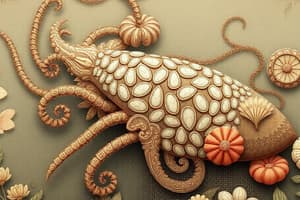Podcast
Questions and Answers
Which of the following molluscs has a highly developed brain and nervous system?
Which of the following molluscs has a highly developed brain and nervous system?
- Bivalvia
- Cephalopoda (correct)
- Mollusca
- Gastropoda
What is the primary function of the radula in molluscs?
What is the primary function of the radula in molluscs?
- To rasp and grind food (correct)
- To filter food particles from the water
- To pump blood through the body
- To secrete the shell
Which of the following arthropod subphyla is characterized by a side-to-side jaw movement?
Which of the following arthropod subphyla is characterized by a side-to-side jaw movement?
- Mandibulates
- Crustacea
- Myriapoda
- Chelicerates (correct)
What is the primary function of the spiracles in insects?
What is the primary function of the spiracles in insects?
Which of the following insects undergoes incomplete metamorphosis?
Which of the following insects undergoes incomplete metamorphosis?
What is the primary function of the Malpighian tubules in arachnids?
What is the primary function of the Malpighian tubules in arachnids?
What do honeybees use to relay vital information about death and food?
What do honeybees use to relay vital information about death and food?
Which of the following molluscs has a sessile lifestyle?
Which of the following molluscs has a sessile lifestyle?
What is the primary function of the book lung in arachnids?
What is the primary function of the book lung in arachnids?
What is the purpose of the Waggle Dance in honeybees?
What is the purpose of the Waggle Dance in honeybees?
Which of the following characteristics is NOT unique to phylum Echinodermata?
Which of the following characteristics is NOT unique to phylum Echinodermata?
Which of the following arthropod classes has a calcium chitin skeletal system?
Which of the following arthropod classes has a calcium chitin skeletal system?
What is the primary function of the pedipalps in arachnids?
What is the primary function of the pedipalps in arachnids?
How do honeybees cool their nests?
How do honeybees cool their nests?
What is a characteristic of the digestive system in phylum Echinodermata?
What is a characteristic of the digestive system in phylum Echinodermata?
Flashcards are hidden until you start studying
Study Notes
Phylum Mollusca
- Soft-bodied, mostly protected by a hard shell
- Characterized by muscular foot, visceral mass, and mantle that secretes the shell
- Protostomes, with a water-filled cavity and radula (rasping tongue)
- Torsion, a unique body structure
Classifications of Mollusca
- Gastropoda (snails and slugs)
- Stomach foot
- Have an opening, head, and nervous system
- Simple brain, complete digestive system, and circulation
- Gas exchange through gills or simple lungs
- Hermaphroditic, with nephridia present
- Bivalvia (clams and oysters)
- Often marine, no head, and sessile filter feeders
- Digestive system complete, gills trap food
- Rudimentary nervous system, circulation pumped by two-chambered heart
- Gas exchange through gills
- Cephalopoda (squids, octopus, cuttlefish, and chambered nautiluses)
- Head-foot, shell is internalized
- Specialized foot as a tentacle, highly cephalized
- Highly developed brain and nervous system
- Closed circulatory system, gill gas exchange
Phylum Arthropoda
- Protostomes, largest phylum
- Important for pollination (economy and environmental)
- Three body parts in insects (head, thorax, abdomen), two in spiders (cephalothorax and abdomen)
- Jointed appendages from thorax, specialized for various functions
- Chitin external skeleton, spiracles, metameric segmentation
- Open blood system, sexes usually separate (females sting)
- Highly motile, developed social behavior
Subphyla of Arthropoda
- Chelicerates
- Jaw moves side to side
- Mandibulates
- Have an up and down jaw
Classes of Arthropoda
- Arachnida (spiders, scorpions, and ticks)
- Cephalothorax and abdomen
- Four pairs of walking legs, chelicera, pedipalps
- Well-developed nervous system with sensory hairs and eyes
- Book lung, open circulation, complete digestive system (bite/inject prey)
- Malpighian tubule excretion
- Insecta (butterflies, bees, dragonflies)
- 30 orders of insects, first animals to fly
- Live in almost every terrestrial habitat, rare in marine habitats
- Segmented into head, thorax, and abdomen
- Well-developed brain
- Myriapoda (centipedes and millipedes)
- Terrestrial, jaw like mandibles
- Centipedes are carnivores, one pair of leg per segment
- Millipedes feed on dead organic matter, two pairs of legs per segment
- Crustacea (crabs, shrimp, lobster, crayfish)
- Aquatic, mandible jaw
- Branched appendages for feeding and locomotion
- Many have gill appendages, open circulation
- Green gland excretion, calcium chitin skeletal system
- Complex nervous system
Life Cycle of Insects
- Incomplete metamorphism: adult resembles young post-metamorphism (e.g., cockroaches)
- Complete metamorphism: adult does not resemble young at all post-metamorphism (e.g., butterflies)
Social Behavior in Insects
- Honeybees maintain nest temperature at 30°C, even in extreme climates
- They cool the nest by spreading water and fanning their wings
- They also vibrate their wings and bodies to heat up the nest
- Communication in honeybees involves chemical release of pheromones to relay vital information
- Two methods of communication: Round Dance and Waggle Dance
Phylum Echinodermata
- Deuterostomes, with second opening as the mouth
- Coelomates, with tube feet (suction cup)
- Pentaradial symmetry, no head, short complete digestive system
- Can push digestive system outside of their body
- Simple circulation, endoskeleton
Studying That Suits You
Use AI to generate personalized quizzes and flashcards to suit your learning preferences.



